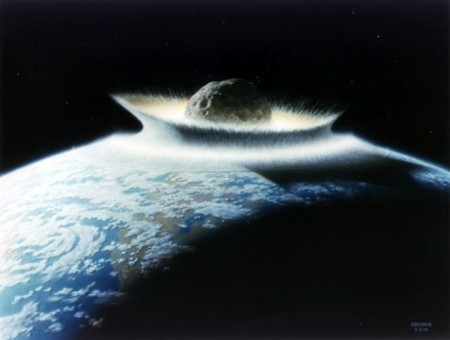
It’s not “Armageddon,” but it’s close.
The European Space Agency (ESA), NASA, the Secure World Foundation and others have been intently studying the skies lately — worrying about how to deflect a potential planet-shattering asteroid.
No such space rock has been detected yet, despite Internet chatter about the 1,600-foot-wide asteroid Apophis that space experts predict will skirt Earth by a few hundred thousand miles in 2036. But as in the movie “Armageddon,” it’s always an option — one scientists are watching and worrying about.
“It has happened in the past. And it will happen again,” Dr Gerhard Drolshagen from the European Space Agency’s Space Situational Awareness program office told FoxNews.com.
In Bruce Willis’ Hollywood blockbuster, a team of space jockeys try to blow up an asteroid on a path for Earth. That’s one option, of course: The ESA at one time conceived an asteroid-busting plan along similar lines.
Called “Don Quijote,” the 2005 concept by the ESA that involves firing a so-called “impactor” satellite into a “test” asteroid in 2015 to see if it knocks the space rock off course. It’s no bomb as in the film, but still intriguing.
“If an asteroid were ever detected, we’d want to do something — and deflection is definitely one of the options,” an ESA source told FoxNews.com. But despite a Daily Mail story touting the program as current, Don Quijote has long been shuttered.
“The Don Quijote mission has been a study only. ESA is not working on this mission anymore,” ESA spokesman Andreas Schepers told FoxNews.com.
Nevertheless, the ESA and several other space players in the last decade have worked on mission plans on how best to deflect an asteroid. NASA intentionally sent an impactor probe crashing into the comet Tempel 1 in July 2005, for example.
Europe’s space agency has recently concentrated its asteroid eyes in the SSA, which will rely on specially constructed telescopes, amateurs astronomers, and collaboration with outside agencies such as the Smithsonian Institute’s Minor Planet Center and the Secure World Foundation to study the skies for dangers.
It envisions several wild ways to deflect an asteroid, Drolshagen told FoxNews.com. And the “Armageddon”-style technique isn’t necessarily the best one.
“You don’t do it like Bruce Willis. That’s not the way to do it,” he said.
Readjusting an asteroid’s path could be as simple spreading a big white sheet of plastic over it. If detected far enough out in space, the force of the solar beams striking the sheet alone would probably be enough to move it.
“Paint it white to increase the reflectivity,” Drolshagen said.
Alternately, a satellite could land a little motor with a thruster on the asteroid; a force akin to your breath on your hand would be sufficient to deflect an asteroid’s path, given it was detected far enough away.
Or you could just use a laser.
“You could point laser beam at the surface and eject some materials from it” he suggested. “This you could do in a very controlled way.”
A third idea: a “mass projector” that would slowly chisel away at the surface. There’s also the concept of a gravity tractor — a massive spacecraft a few tons in size that could slow tug an asteroid off path with the force of its sheer bulk.
“If you have several weeks or months, you could slowly push it away,” Drolshagen told FoxNews.com. “A little push — a centimeter per second in velocity change — would be enough if you had 20 years time.”
And those are the realistic ideas, he said, citing several more exotic concepts: An explosion near the surface that could eject material, lasers, magnetic tractors, even sails to harness the solar winds.
However, if an asteroid is found hurtling towards us with only months to spare, we’re in trouble.
“Blowing it apart is likely not possible” if it isn’t detected far enough out, he warned. “Right now we would not be able to do it and there no plans to do it — but it’s not a good idea anyway.”
Fortunately, most of the large asteroids nearby have already been detected, experts agree. But even small ones could have devastating potential.
“Anything more than 300 to 400 meters (983-1,312 feet) in diameter can cause continental-scale damage,” Stephen Wolters, a research fellow at Caltech who studies near-Earth asteroids at NASA’s Jet Propulsion Laboratory, told Space.com.
That’s why the ESA program exists, as well as similar programs from NASA and other space agencies.
There’s always a fallback option, however.
“If everything else fails we might call in Bruce Willis,” Drolshagen told FoxNews.com.
